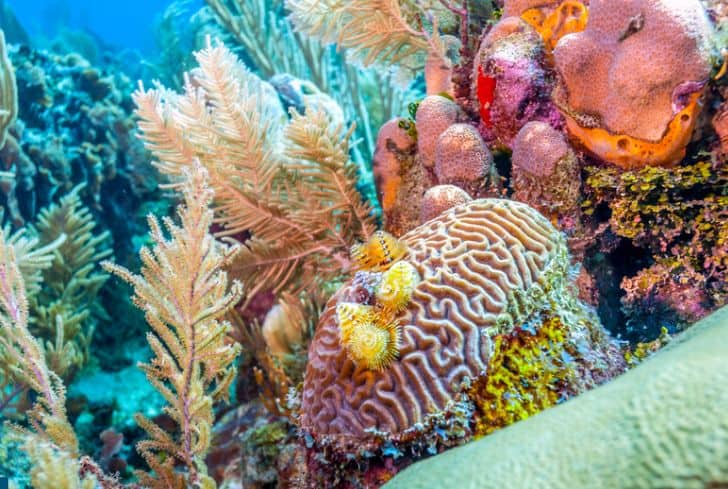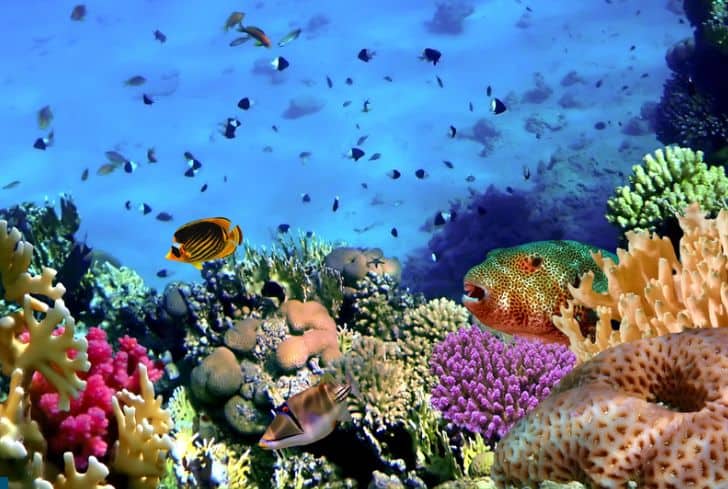Since corals are living creatures that create geological structures, the research on coral reefs represents a unique nexus of biology and geology. Coral polyps employ carbonate ions and calcium from the salt water to create a rigid skeleton and construct the reef, earning them the moniker “ecosystem engineers.”
By providing habitats for other organisms and frequently regulating the availability of resources, coral reefs operate as ecosystem engineers. Read on to find out more about these organisms.
What Are Ecosystem Engineers?
Ecosystem engineers are organisms that alter the physical states of abiotic or biotic materials to affect how readily available resources are to other species, modifying, maintaining, or even creating habitats.
Any species that builds, dramatically alters, maintains, or eliminates an environment is considered an ecosystem engineer. These organisms can significantly affect a region’s species richness and level of landscape variability.
Therefore, ecosystem engineers play a crucial role in preserving the stability and health of the habitat they live in. It has been suggested that the title “ecosystem engineers” only be applied to keystone species whose activity significantly impacts other creatures because all organisms have some impact on the planet they live on.
When examining the potential influence ecosystem engineers might have over other animals residing in the same environment, particularly regarding resource availability, it can be vital to recognize these individuals.
It is also critical to understand that ecosystem engineers cannot be creatures that actively transfer live or decaying tissue to other organisms. They are classified as engineers, then, not because of their trophic effect but because of their capacity to change resources.
Keystone species can have an equally significant impact as ecosystem engineers, but their impacts differ.
Below are the two main types of ecosystem engineers:
Autogenic Engineers
Autogenic engineers alter their surroundings while altering themselves. As they develop, trees’ trunks and branches provide homes for various living things, such as insects, birds, and squirrels.
Trees are a fantastic illustration of this. Many creatures in the tropics can only move across the wood canopy thanks to the lianas that connect the trees.
Allogenic Engineers
Allogenic engineers who mechanically transform living or nonliving elements alter the physical and biological setting. Beavers are the first version example of ecosystem engineers since they significantly alter their ecology through damming and clear-cutting.
The construction of a dam could impact the amount and distribution of many creatures in the area. Another instance is how caterpillars build shelters from leaves for other species that may live there concurrently or afterward.
Understanding Coral Reefs
Coral polyp colonies, often known as coral reefs, range from hundreds to thousands. These sessile marine invertebrate creatures have strong calcium carbonate exoskeletons. Based on the species, polyps form various forms and sizes as they slowly grow.
Corals help create intricate, three-dimensional reefs with other creatures with coralline algae and calcium carbonate skeletons.
Coral reefs support a vital ecology for marine life, giving fish, mollusks, sea urchins, sponges, and other creatures food and refuge within their branches and crevices.
Shallow coral reefs comprise some of the planet’s most diversified ecosystems and are sometimes called underwater rainforests. In ocean conditions with few nutrients, coral reefs thrive.
Coral reefs can be found on a lesser scope in cold and deep water but are most frequently seen at shallow levels in tropical environments.
After the Last Glacial Period, when melting ice allowed sea levels to increase, most coral reefs were developed. Several coral reefs are only a few thousand years old.
As towns flourished, the reefs grew, keeping pace with rising sea levels. Without enough light, reefs that climbed too slowly risk drowning. Coral reefs can also be found in the deep ocean, close to oceanic islands and atolls, and distant from continental shelves.
A great deal of these islets is the result of volcanic activity. Others were created by plate tectonics, whereby shifting plates raised the deep sea floor. The back reef, reef crest, and fore reef are three unique areas that make up coral reefs.
The shallow lagoon between the coast and the coral reef is part of the back reef. Sand fields, seagrass beds, and small coral patches can all be found in this habitat. Due to its short depth, low water velocity, and wave protection, the back reef is frequently warmer.
The reef’s peak, or reef crest, can be seen from the air during shallow tides. The reef crest is an unforgiving environment with the risk of UV stress and desiccation from an external environment.
In addition, only a few species of coral can survive in this high-energy region due to breaking waves, which reduces coral diversity. The fore-reef, which extends below the water’s depth to a sand plain, starts on the reef’s ocean side.
The forereef’s abiotic conditions are less harsh than those in other areas and are best for coral growth. Due to easy access to light, the fore-reef has the greatest diversity of corals.

Role of Coral Reefs as Ecosystem Engineers
Yes, coral reefs are considered ecosystem engineers because they play a critical role in shaping and maintaining the structure and function of the ecosystems they inhabit. Coral reefs provide habitat and shelter for a wide variety of marine species, and they also help to regulate the nutrient and carbon cycles in the oceans.
Additionally, coral reefs protect coastlines from erosion and storm damage and contribute to local economies through tourism and fisheries. Overall, coral reefs are essential components of healthy marine ecosystems and are vital for the sustainability of ocean life and human well-being.
Provision of Food and Shelter For Marine Organisms
Coral reefs safeguard their environment by obstructing and halting erosion on the rest of the earth, but they also stop erosion’s harmful effects on nearby terrestrial ecosystems. By doing this, the built-up infrastructure and the natural habitats on the mainland are protected.
In general, coral reefs are ecosystem engineers because of the habitat they provide, which provides space for a variety of fish and marine invertebrates. The infrastructure required for the many coral reef animals to live is provided by the coral reefs, much as human engineers construct and create new structures and infrastructure.
Oceanic tropical woodlands or oases have been used to characterize coral reefs. Coral reefs play a significant function in the aquatic environment by acting as a haven for various ocean species and reproductive sites for them.
Although living corals come in various hues, including brown, purple, and green, these hues are caused by tiny, symbiotically coexisting single-celled algae called zooxanthellae.
The zooxanthellae live inside corals, giving oxygen from photosynthesis and organic stuff like protein and carbohydrates that the corals consume as nutrition.
The corals release some of this organic material as a viscous fluid which serves as a foundation for the diverse marine ecology by supplying nutrients for microscopic animals.
Threat To Coral Reefs
Among the most important ecosystems on earth is a healthy coral reef system. However, the consequences of climate change, irresponsible fishing practices, and land-based pollution are the greatest threats to coral ecosystems.
Irresponsible Fishing Practices
Irresponsible fishing practices can result in the extinction of ecologically and commercially important fish species in coral reef ecosystems. Such losses frequently have a knock-on effect on the local economy as well as the coral reef systems themselves.
The threatening methods include blast fishing. The technique of blast fishing is present in about 40 nations. It employs powerful explosives like dynamite, indiscriminately killing numerous fish and algae. Additionally, it stresses coral reefs, which causes widespread deterioration of them.
Climate Change
By raising the temperature of the ocean surface, climate change damages coral reef ecosystems and causes disease, coral bleaching, storm activity, and sea level rise. Additionally, rising atmospheric carbon dioxide alters the ocean’s chemistry and damages corals that build reefs.
Corals exposed throughout the day are subjected to a lot of UV light from the Sun, which can raise the coral’s temperature and cause its tissues to dry out.
Land-based Pollution
Coral reproduction and development can be hampered, biological processes can be disturbed, and the impact of land-based forms of pollution, including agricultural runoff and coastal development, can bring on disease.
Sedimentation
The sediment discharge in coastal locations has grown significantly over the last few decades due to expanding development for various reasons, such as recreation. The sediments cover the corals as they sink to the bottom.
They successfully obstruct the coral lips. The corals’ nourishment is diminished as a result. Additionally, sediments that may contain a variety of substances could be ingested. Due to this, there is a higher chance that corals may become endangered.
Conservation Efforts And Solutions
The world’s coral reefs need to be saved and restored, and this calls for a multifaceted strategy that spans the local and global scales. Despite remarkable achievements in the neighborhood, there is still a long way to go before we can substantially impact the ecosystem.
Green Up Your Lawn Care
Regardless of how far you are from a coral reef, the items you use on your lawn will ultimately find their way into the water supply. Use environmentally friendly insecticides and fertilizers that will not affect coral reefs or other marine life.
Use A Sunscreen Safe For The Reefs
Octinoxate and oybenzone are two prominent sunscreen chemicals that have been demonstrated to be harmful to coral reefs. Coral bleaching is not a result of sunscreens using non-nano zinc oxide as an active ingredient.
Dive Safely Among Coral Reefs
Refrain from touching or mooring your boat on reefs. The delicate coral organisms will be harmed by contact with the reef, and staying on the reef can cause coral death.
Conclusion
In general, coral reefs are ecosystem engineers because of the habitat they provide, which provides space for a variety of fish and marine invertebrates. The coral reefs provide the infrastructure required for the many coral reef animals to live, much as human engineers construct and create new structures and infrastructure.






